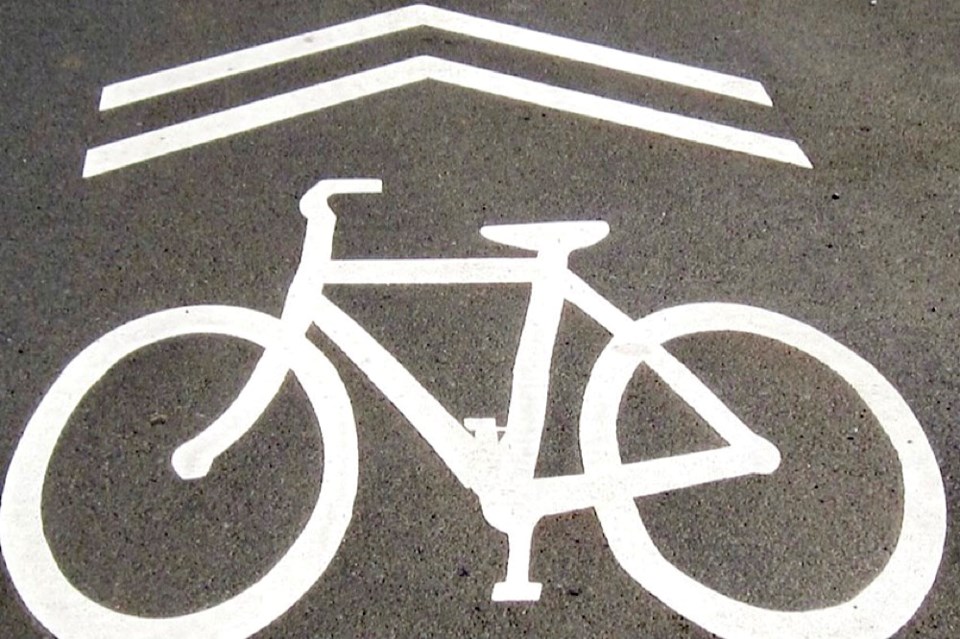If you were driving downtown on Queen Street and saw the pavement marking shown above, would you take it to indicate a bike lane?
If so, you'd be wrong.
But you wouldn't be alone.
It's called a 'sharrow' and city officials are seriously thinking about painting the controversial symbol all over the blacktop of our downtown after the Queen Street construction work expected to start next year.
Search the word on Google News you'll find headlines including "How sharrows became cycling's most hated symbol," "Early sharrow booster: I was wrong," and "Sharrows suck."
Consisting of a bicycle with two arrows above it, the sharrow symbol is marked on roadways to advise that motor vehicles and bicycles are to share the lane.
A sharrow doesn't delineate an exclusive, separated space for cyclists.
Instead, it suggests a preferred route for bicycles while sharing the road with other vehicles.
The idea is to make interactions between drivers and cyclists more predictable, reducing the possibility of conflicts.
The United States Manual on Uniform Traffic Control Devices suggests the following uses for shared-lane markings:
- assist cyclists with lateral positioning in a shared lane with on-street parallel parking in order to reduce the chance of a bicyclist impacting the open door of a parked vehicle
- assist cyclists with lateral positioning in lanes that are too narrow for a motor vehicle and a bicycle to travel side by side within the same traffic lane
- alert motorists of the lateral location bicyclists are likely to occupy within the travelled way
- encourage safe passing of bicyclists by motorists
- reduce incidence of wrong-way bicycling
But sharrows are often misinterpreted as bicycle-only lanes.
Critics argue that they provide no physical separation between bikes and vehicles, leading to a false sense of security for both drivers and cyclists.
Some cities, they say, are just slapping down sharrows because they're an easy alternative to bike lanes.
Sault Ste. Marie is preparing to rebuild Queen Street from Pim to Gore, starting next year.
At a public information session this week, city planners presented three options for downtown cyclists:
- cyclists sharing the road with vehicular traffic, with no designated pavement markings or signage. This is essentially a 'do nothing' option
- cyclists sharing the road with vehicular traffic in a designated sharrow lane on the north side of Queen Street
- a designated bicycle lane with 0.6-metre buffer between cyclists and on-street parking
The first two of these options would be accompanied by speed limit reductions.
The latter option, planners suggest, would produce less boulevard area for downtown's popular summer patios, but it would significantly reduce the number of bicycles colliding with open doors on parked vehicles.
Parts of Queen Street with no parking on the street will lose 0.3 metres of boulevard on the north and south side.
Areas with parking on one or both sides of the street will lose 0.85 metres of boulevard on the north side and 0.3 metres on the south side.
Local cycling advocate Andre Riopel wants a designated bike lane.
"Currently downtown Queen Street is a hostile and dangerous place for bicycles," Riopel said in a social media post this week.
"There are many cyclists and would-be cyclists who won’t go downtown Queen or simply ride on the sidewalk."
"Our vision is one lane of car traffic with a bike lane on each side going in opposite directions or a segregated bi-directional bikeway. The bike lanes could be grade separated and or protected by bollards leaving room for curb side parking, bus and delivery bays," Riopel wrote.
Salvatore Marchese, junior city planner, said input received from this week's public information session must still be studied, but he said there appeared to be a consensus on one point.
"People do want to make sure we acknowledge that people are bicycling on Queen, and how can we make that a more pleasurable experience," Marchese told SooToday.
All major changes to the design of Queen Street will require approval from city council.
